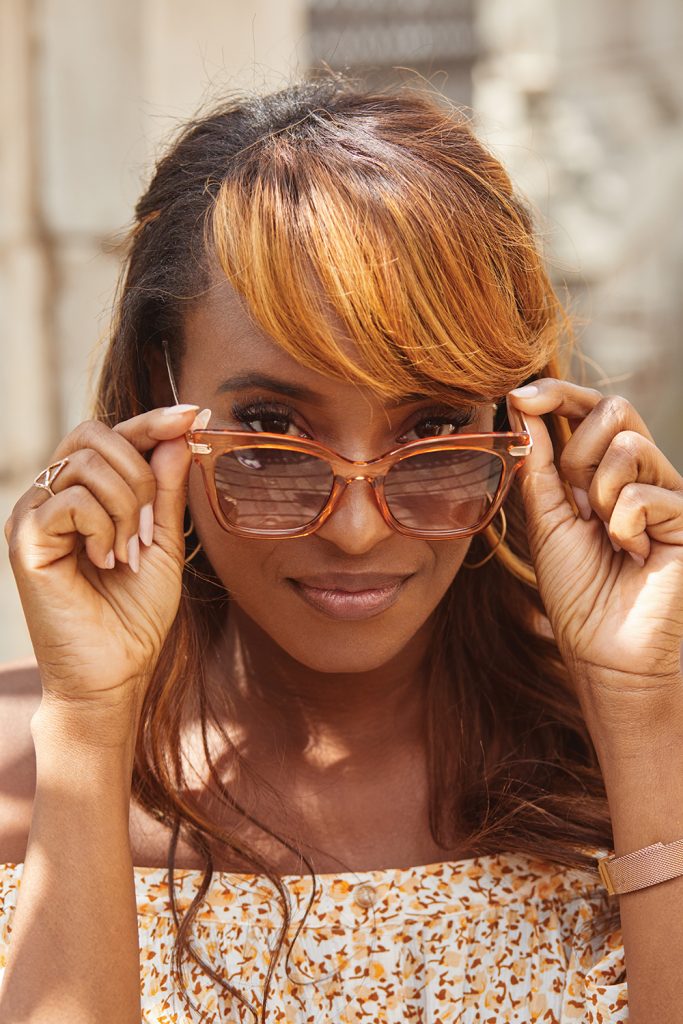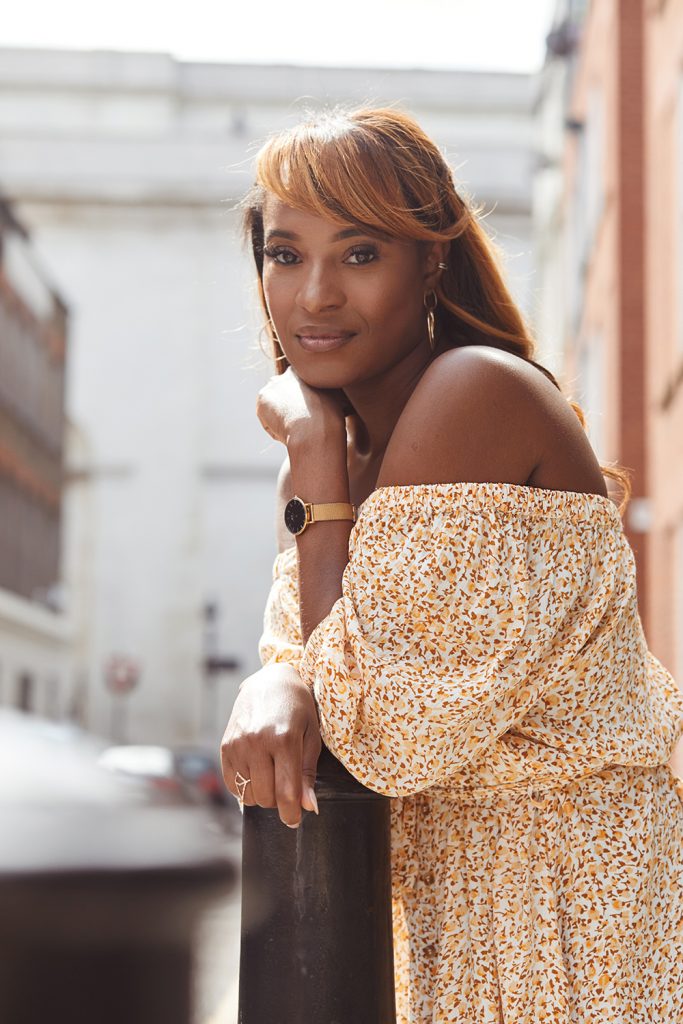We talk to the style Instagrammer about how she grew her following, the importance of industry friendships and why we’re still demanding more diversity from brands
Photography: Kyle Galvin

On a street that wouldn’t look out of place in a Victorian period drama on ITV, Nimi Blackwell is gazing down the camera lens as she poses for our photographer. Fashion influencer Nimi, 37, is a pro when it comes to creating stylish content, but her current career is polar opposite to her previous job roles.
“I’ve always been a PA, so before I started blogging I was an assistant and I worked in lots of different industries. I started in the financial sector, which is very different to what I do now. I was in the financial industry for about eight years, and then I moved into a more creative world. I worked for Getty Images, which is more similar to what I do now. I had access to the editorial and entertainment teams, so I saw first-hand what freelance photographers were doing. It really opened my eyes to the creative industry. I also worked for an advertising company for a bit and there I learnt more about social media campaigns.
“It was actually by accident, around three years ago, that I came across the world of blogging. When I was in the advertising world, I worked with a girl who created content just as a hobby. I was always really into fashion, so she told me to set up an Instagram and just get content out there for people to see. People would always ask me where I got my clothes from, so it seemed like a good idea. I started doing it, shooting photos on my phone, and then I started to grow a following. When I left Getty Images I already had a following of around 60,000 on Instagram because I used to re-gram their content as a hobby. So I had this account already to use, and I turned it into my own personal account. Already having a following was a great platform for me to start from.”

Although it may seem ideal to be able to start your career as a content creator with an already established social media account, Nimi did lose some followers when she first started to share her style content. Luckily, as she persisted with sharing style content she quickly regained the lost followers and has now managed to grow her account to 200,000+ followers.
“I lost some followers when I first started to post my own content, probably because that wasn’t the content they were used to seeing from my account. “But I did have some followers DM me and say it was really cool that I was now sharing my own content. The content I used to re-gram was mainly editorial content anyway so it wasn’t a massive deviation when I started to share my own street style content. I had such a big following to start with, so I don’t know if that meant the algorithm pushed my content out there more. It’s impossible to know, but at the time I would regularly get onto the explore page and hashtags would also perform really well for me. I was getting at least 2,000 likes on each of my photos, my engagement was really good and I grew quickly. It was a lot easier to grow back then, compared to now.”
There’s no denying that in recent years, and even over the past year, Instagram has become a much harder platform for content creators to establish themselves on. Even with an established following, it can be hard to get your content seen or attract the attention of brands. Nimi feels that the social group of influencers that she has built has really helped her to get onto the radar of the right brands, which therefore brings in more paid work.
“The great thing about the industry is that the people I’ve made friends with are always willing to share. It can be very competitive but I’ve got a great circle of friends and we share contacts. If my friends are struggling and I’ve been booked for a campaign I will recommend them for it. It really does depend on who you make friends with in this industry. It can be cut-throat because some people don’t want to be seen to be doing the same campaigns as other people. I’m really lucky because I’ve built up a great list of contacts, as have my friends, and we share them all the time between ourselves. We also give each other advice about how to get a brand’s attention. To be honest, this year was a big change for me in terms of the kind of work I took on. I think I’ve only been able to get more into the fashion space because of the people I’m friends with. “One particular campaign I got was with New Look, and I wouldn’t have got it without a really good friend of mine who already had them as a contact. Now I have a really great relationship with New Look. It really does help to have friends who are with you.”

While Nimi enjoys working with brands on collaborations and trips, she feels there is still a lack of diversity in who these opportunities are offered to.
“I don’t think there’s enough diversity yet within the industry. There’s still an educational component that is missing. A lot of brands are wise to it and they are working more with influencers who are from ethnic minorities, or disabled. “In terms of what we can do to change it, we need to keep talking about it and sharing our experiences. It’s only from keeping the conversation going that we can reach the ears of the people at the top. There’s only so much influencers can do, but if you’re in a room with a brand and everyone looks the same and has the same abilities that’s not going to change things.
“The good thing is that those of us who regularly talk to brands and PRs are telling them we want to see more diversity, and they are listening. There have been quite a few occasions now where I’ve been asked to suggest people who would be good for a trip or campaign and that’s where we can have the impact and recommend a more diverse pool of people. That’s where we can really make a difference, and as long as we continue to cultivate our relationships with brands and PRs and deliver that message, they will start to make the change. After Revolve were called out for only really working with white influencers I have noticed a change from them. There’s far more diversity on their trips, which is massive. “Beyoncé was recently asked to do a campaign with Nike and she said no, because there was a lack of diversity in the room, so she went to Adidas and signed with them instead.”
As well as putting more diverse people on brands’ radars, Nimi believes it is important that content creators talk openly about how much they are paid for campaigns to ensure that nobody is being underpaid.

“I’ve always been an advocate for being open about fees. The industry is still really new, and people are still learning new things everyday. One of the biggest topics of conversation is what we should all be getting paid. “I’m very open about it, so if someone I know is doing the same paid campaign as me, I will find out what they’re being paid, because I want to know it’s a fair conversation. Some platforms offer a flat fee to everyone, regardless of their following, because it’s purely based on your content. I don’t know how I feel about that, on the one hand it feels unfair because someone who has only been doing it for a few months would be paid the same as you (even if you have far more followers and experience in creating content). But at the same time maybe following shouldn’t matter? It’s an ongoing debate and I don’t know what the right answer is. I think it’s about being aware of those things when you accept certain paid work.”
To those at the beginning of their social media journeys, it can seem impossible to build an audience in such a saturated industry. Nimi has the ‘following’ advice for those of us looking to make our mark as style content creators.

“You need to have a story, people need to know what you’re about. You need to have a theme – that doesn’t mean your content has to be overly edited or filtered – I just mean there needs to be some form of message behind every post. It’s also good to have a niche, decide on what type of content you’re going to share and stick to it. If I were a brand or agency, I would want to be able to land on your page and think ‘she’s Chanel’ or ‘she’s H&M’. If you’re looking at it as a business and want to make a living from it you need to be savvy about your content – are you shooting on an iPhone or a DSLR? Is your content editorial or more girl-next-door? Think about those things because they will form the basis of your content and the brands you attract to your feed.”
